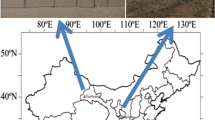Summary
The present study covers the soil layer surface to a depth of 120 cm. It is found that for the sandy and loamy sand soil of the arid zone of Jodhpur, there are 2 types of thermal regime patterns viz.
-
1)
Summer pattern: In this soil temperature decreases from the surface all the way during maximum temperature epoch. During minimum temperature epoch of the air, temperature increases from surface to 30 cm depth and thereafter it decreases.
-
2)
Winter pattern: In this, soil temperature decreases only upto 30 cm depth and thereafter increases during maximum temperature epoch. During minimum temperature epoch, the temperature increases continuously from the surface all the way. The summer pattern lasts from mid-March to mid-October with breaks during peak monsoon periods when winter pattern is obtained. Conditions are favourable for upward movement of moisture in vapour phase during the morning hours and for downward flow during afternoon hours throughout the year. The gradients are stronger from mid-March to end of October.
Zusammenfassung
Die Untersuchung bezieht sich auf die Bodenschicht von der Oberfläche bis 120 cm Tiefe. Für sandigen und lehmigen Sandboden in der ariden Zone von Jodhpur wurden zwei Typen der Temperaturverteilung festsgestellt: 1. Im Sommer nimmt zur Zeit des Maximums der Lufttemperatur die Bodentemperatur von der Oberfläche bis 120 cm Tiefe ab; zur Zeit des Minimums der Lufttemperatur nimmt sie von der Oberfläche bis 30 cm Tiefe zu, darunter aber ab. 2. Im Winter nimmt die Bodentemperatur zur Zeit des Maximums der Lufttemperatur nur bis 30 cm Tiefe ab und darunter zu; zur Zeit des Minimums der Lufttemperatur nimmt sie kontinuierlich bis 120 cm Tiefe zu.
Die Sommerform der Verteilung der Bodentemperatur findet sich von Mitte März bis Mitte Oktober mit einer Unterbrechung im Höhepunkt der Monsunperiode, wo die Winterform vorherrscht. Für eine Aufwärtsbewegung der Feuchtigkeit in Dampfform sind die Bedingungen das ganze Jahr hindurch in den Morgenstunden günstig, für die Abwärtsbewegung aber in den Nachmittagsstunden.
Similar content being viewed by others
References
Abichandani, C. T., Krishnan, A., Bhatt, P. N., Rakhecha, P.: Some Observations on Soil Moisture Changes in Arid Zone Soils. J. Ind. Soc. of Soil Science15, 7–15 (1967).
Bouyoucos, G. J.: Effect of Temperature on the Movement of Water Vapour and Capillary Moisture in Soils. J. Agr. Res.5, 141–172 (1915).
Cary, J. W., Taylor, S. A.: Thermally Driven Liquid and Vapour Phase Transfer of Water and Energy in Soil. Proc. Am. Soil Sci. Soc.26, 417 (1962).
Gurr, C. J., Marshall, T. J., Hutton, J. T.: Movement of Water in Soil Due to a Temperature Gradient. Soil Sci.74, 335–345 (1952).
Krishnan, A., Bhatt, P. N., Rakhecha, P.: A Soil Moisture Regime and Microclimatological Study Over Sand Dunes in Western Rajasthan. Ann. Arid Zone5, 1–9 (1966).
Krishnan, A., Blagoveschensky, E. N., Rakhecha, P.: Water Balance of Prosopis Specigera Community. Ind. J. Meteor. and Geophys.19, 181–192 (1968).
Lebedeff, A. F.: The Movement of Ground and Soil Waters. Proc. First Int. Cong. Soil Sci. Vol. 1, 459–494 (1927).
Mighahid, M. A., Abdel Rehman, A. A.: Bull. Inst. Desert Egypte, Tome III, 25–27 (1953).
Penman, H. L.: Gas and Vapour Movement in Soils. I. The Diffusion of Vapour Through Porous Solids. J. Agric. Sci. Camb.30, 437 (1940).
Philip, J. R., DeVries, D. A.: Moisture Movement in Porous Materials Under Temperature Gradient. Trans. Amer. Geophys. Un.38, 222–232 (1957).
Ramdas, L. A.: Desert Hydrology Condensation and Evaporation Phenomena in the Rajasthan Desert. Bull. Nat. Inst. Sci. India, No. 1. 1952.
Rollins, R. L., Sprangler, M. G., Donkirkham: Movement of Soil Moisture Under a Thermal Gradient. Proc. Highw. Res.33, 492 (1954).
Rose, C. W.: Water Transport in Soil With a Daily Temperature Wave. Aust. J. Soil. Res.6, I. Theory and expt. 31–44, II. Analyses, 45–57 (1968).
Author information
Authors and Affiliations
Additional information
With 2 Figures
Rights and permissions
About this article
Cite this article
Krishnan, A., Rao, G.G.S.N. Soil temperature regime in the arid zone of India. Arch. Met. Geoph. Biokl. B. 27, 15–22 (1979). https://doi.org/10.1007/BF02245906
Received:
Issue Date:
DOI: https://doi.org/10.1007/BF02245906




